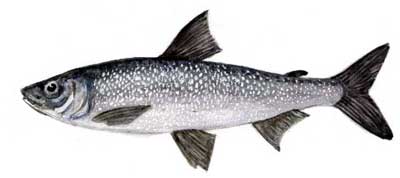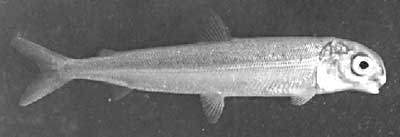Hello, Guest!
Fishes
Baikal omul
Coregonus autumnalis migratorius Georgi, 1775

Undoubtedly, the most famous fish among whitefish is the Baikal omul. I.G. Georgi was the first who described the omul (1775). In 1932, L.S. Berg named the omul a migrating whitefish. This feature was reflected in its name. The characteristic features of the omul are as follows: terminal mouth, long thin gill rakers the number of which varies from 35 to 54, small scales, large eyes, and relatively small sizes. Some individuals of 30-60 cm long can weigh from 200 g to 1.5 kg. The two-kg individuals are met very seldom.
The Arctic omul penetrated Lake Baikal from the Arctic Ocean via the river system during the last glaciation about 20 thousand years ago. As a result of its adaptation to habitat conditions in the lake, the omul has intraspecies forms which differ both in a number of morphological characteristics and in peculiarities of ecology. At present, there are three groups of the omul with ecological and morphological differences: a pelagic group (Selenginskaya), a coastal group (North-Baikalian and Barguzinskaya), and near-bottom deepwater group (Posolskaya, Chivyrkuiskaya and other populations reproducing in small rivers). Populations spawning in tributaries of different length of Lake Baikal are the basis of each group.
The omul belongs to the autumn spawning type. In September and October, when the water temperature is 10-13ºC and 3-4ºC, correspondingly, two shoals of omul enter the rivers of the Posolsk Sor (Bolshaya, Kultuchnaya, and Abramikha) for reproduction. The omul spawns on the stony-pebble substrate where there is a swift current. Spawning usually occurs at sunset and at night. After spawning the omul rolls down to the lake. Hard-roes are glued to the substrate. Embryogenesis continues for 190-200 days on the average at water temperature 0.2-2ºC. Larvae of 10-12.5 mm long and 6-7 mg of weight appear in late April-early May when the water temperature ranges between 0.2 and 6.5ºC. Hatched larvae are drifted by the current to the Posolsk Sor where they grow and feed. Larvae feed intensively on planktonic organisms till the age of 30 days, having in their ratio over 55 species of invertebrates belonging to 15 different groups.

Larva of the omul

Fry of the omul
The pelagic omul (multiraker) spawns in the largest tributary of Lake Baikal – in the Selenga River. It has a cigar-shaped body, large eyes, narrow tail fin, and rakers often located on the gill arch (44-55). It inhabits the pelagic zone of Lake Baikal. During spawning it goes upstream at a distance of 1600 km. This omul feeds on organisms which inhabit the water column: zooplankton, Macrohectopus, pelagic sculpins, and their larvae. It winters at a depth of 200-300 m.
The coastal omul (with a medium number of rakers) spawns in the rivers of middle length. It has a long head, high body, tail fin, and randomly located gill rakers (40-48). It fattens in the coastal zone of Lake Baikal and spawns in such rivers as the Upper Angara (640 km), the Kichera (150 km), and the Barguzin (400 km). This omul feeds on zooplankton (23%), Macrohectopus of medium size (34%), pelagic sculpins (26%), and other organisms (17%).
The near-bottom deepwater omul (a low number of rakers) inhabits Lake Baikal up to the depth of 350 m. It has a high body, tail fin, long head, and a low number (36-44) of coarse and long gill rakers. It spawns in small tributaries of Lake Baikal with a spawning distance from 3-5 km (the Bezymyanka River and the Maly Chivyrkui River) to 20-30 km (the Bolshoy Chivyrkui River and the Bolshaya Rechka). The prevailing food of this omul is Macrohectopus of medium size (52%), fish (25%), benthic gammarids (12 %), and zooplankton (10%). The Posolsky omul is artificially bred at the Bolsherechensky Fish Breeding Farm.
The omul is a valuable commercial fish of Lake Baikal. In 1969, scientists recorded a significant reduction in the omul abundance. Therefore, there was a ban on omul fishing. Thanks to diverse nature protection measures its abundance was restored by 1979, and the ban was abolished. At present, the abundance is being drastically reduced because of active fishing.
Copyright © 2005-2010 ЦНИТ ИГУ, 

Дизайн web-студия ЦНИТ ИГУ



